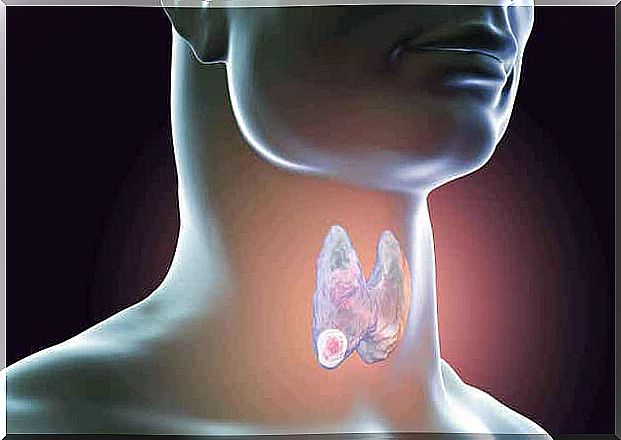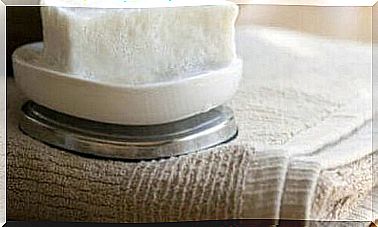A Thyroid Biopsy: Everything You Need To Know

A thyroid biopsy is a procedure that is very commonly used today. It allows specialists to take samples from the gland and analyze them in the lab. Doctors can diagnose or rule out many diseases, such as cancer, by doing a thyroid biopsy.
There are several methods of doing a biopsy. The most common use fine needle aspiration, although other methods help when a clear diagnosis was not possible.
Thyroid biopsy allows doctors to use specific treatment depending on the disease. That’s why in this article we’ll explain everything you need to know about this research, how it’s conducted and what it’s used for.
What does a thyroid biopsy consist of?
A thyroid biopsy is a procedure used to diagnose various diseases that affect this gland. The thyroid is an organ in the front of the neck, in front of the trachea. It is responsible for the production of hormones that play a fundamental role in driving metabolism.
A thyroid biopsy removes a piece of thyroid tissue. Specialists then examine this sample in the lab and analyze it under the microscope.
As we mentioned in the introduction, there are several ways to run it. The most common method is a fine needle aspiration. In this case, the examination usually takes place on an outpatient basis with only local anesthesia.
However, other techniques require general anesthesia and are slightly more complex. The goal is to obtain some of the nodules that have appeared. In general, samples are taken that can be felt through the skin.
As a publication in RadiologyInfo states (Spanish link), the nodules from which the sample is obtained are usually slightly larger than 1 cm. In order to perform this examination in a safer or more targeted way, doctors perform an ultrasound at the same time. This makes it easier to pinpoint the exact position of the nodules, especially if they are small.
Types of Thyroid Biopsies

There are several ways to perform a thyroid biopsy. There are generally two types: needle biopsies and open biopsies. In the following sections we will explain what each species consists of.
1. Needle Biopsy
A needle biopsy may involve needles of different calibers. Within this group we find the fine-needle aspiration biopsy. This is the most commonly used way. According to specialists at the Mayo Clinic, doctors use a thin, hollow needle to extract the cells.
It is usually combined with a simultaneous ultrasound to guide the needle to the specific point. This technique takes place in the hospital or doctor’s office. It takes about 10 minutes and does not require general anesthesia as it is a minimally invasive examination.
To perform it, the patient must lie on his back and stretch his neck. The patient must remain still and not move during the process, as any movement can affect the direction of the needle.
Needle biopsies can also be done with a thick needle. This allows samples to be taken the size of a grain of rice. It is important to take samples from the different nodules in the gland.
Once the process is complete, the area is cleaned and a bandage is applied to the site(s) where the needle was inserted. It is normal to have some mild discomfort in the area afterward.
2. An Open Thyroid Biopsy
A thyroid biopsy can also be done surgically. In this case it is called an open biopsy. It consists of making a small cut on the neck and removing the lump or taking a sample to send it to the lab.
In some cases, doctors will remove a large portion of the gland. Experts recommend this technique when the needle biopsy has not yielded an accurate diagnosis.
General anesthesia is necessary for this surgery and it must take place in the operating room. It is less common because it carries more risks. For example, it increases the chance of:
- infections
- bleeding
- scars
Why are thyroid biopsies performed?
The purpose of a thyroid biopsy is to determine the cause of a lump that appears in the gland. In most cases, doctors detect them through physical examination. A specialist may also have observed them through an ultrasound or scintigraphy.
- Thanks to this examination, it is possible to see the cells that make up the nodule. This makes it possible to check for malignancy and whether it is cancerous or not.
- A thyroid biopsy is also useful for the study of certain cases of goiter. This is an enlargement of the thyroid gland.
How can you prepare for a thyroid biopsy?
Before performing the biopsy, the doctor should know the patient’s medical history. He needs to know if the patient is on any medication or has any other illness. A preliminary examination is also needed to locate the nodules.
Certain additional tests are performed prior to the biopsy. For example, consider a blood test and an ultrasound.
No specific preparations are needed for a needle biopsy. Since this is an outpatient examination without a general anaesthetic, there is no need to fast beforehand.
When it comes to an open thyroid biopsy, general anesthesia is necessary. Since it is a more complex procedure, doctors will give specific instructions to the patient.
- In this case, the patient should not eat or drink for several hours before the procedure.
- In addition, the patient should rest for several hours after the biopsy.
Possible results

A thyroid biopsy provides a lot of information about the condition of the thyroid gland. After analyzing the sample in the laboratory, doctors create a comprehensive report describing various parameters.
First, they describe the color, consistency and general appearance. They then describe the cells that make up it, both in number and morphology. In this way, as the American Thyroid Association explains, the results of a thyroid biopsy can be as follows:
- Benign: Most biopsies have this result. They are nodules consisting of differentiated cells, without irregularities. Periodic follow-up usually takes place in the following months and no intervention is necessary.
- Suspected malignancy: This type of result means that certain features have been found that indicate a diagnosis of malignancy, but are not conclusive.
- Malignant: This is when detectable cancer cells are present in the sample. The most common thyroid cancer is papillary thyroid cancer. Treatment usually includes surgery.
- Atypia of uncertain significance: This is similar to the suspected malignancy category. While there are worrisome features, there are also features that suggest something benign. It is best to repeat the biopsy if there are any doubts.
- Non-diagnostic: This is when there are not enough cells to make an accurate diagnosis.
Thyroid biopsy is fundamental in cancer research
Finally, we must remember that thyroid biopsies are currently the best way to diagnose cancer of this gland. It not only reveals the presence of malignant cells, but also makes it possible to identify the specific type of tumor.
In this way, it is possible to draw up an appropriate treatment plan, depending on the pathology. In addition, it is an examination that is usually performed on an outpatient basis and has a low risk of complications.








